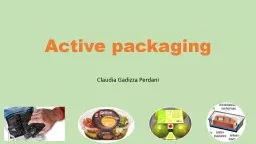

Gadizza Perdani Food packaging Active Packaging Active packaging is accurately defined as packaging in which subsidiary constituents have been deliberately included in or on either the packaging material or ID: 777771
Download The PPT/PDF document "Active packaging Claudia" is the property of its rightful owner. Permission is granted to download and print the materials on this web site for personal, non-commercial use only, and to display it on your personal computer provided you do not modify the materials and that you retain all copyright notices contained in the materials. By downloading content from our website, you accept the terms of this agreement.
Slide1
Active packaging
Claudia Gadizza Perdani
Slide2Food packaging
Slide3Active Packaging
Active packaging is accurately defined as “packaging in
which subsidiary constituents have been deliberately included in or on either the packaging material orthe package headspace to enhance the performance of the package system” (Robertson, 2006)
Slide4Active Packaging: Packaging Gets Active
Active packaging systems are developed with the goal of extending shelf life for foods and increasing the period of time that the food is high quality
Active packaging technologies include some physical, chemical, or biological action which changes interactions between a package, product, and/or headspace of the package in order to get a desired outcome (Yam et al., 2005).
The most common active systems scavenge oxygen from the package or the product and may even be activated by an outside source such as UV light (Gander, 2007)
Active packaging is typically found in two types of systems; sachets and pads which are placed inside of packages, and active ingredients that are incorporated directly into packaging materials.
Slide5Active PackagingType of active packaging:Absorbing (scavenging)– O2, CO2, H2O, ethylene,
flavours, UV,…• Releasing– Ethanol, CO2, preservation agents,…
• Removing– Lactose, cholesterol,…• Temperature control
– ‘Self-heating’, isolating materials,…
Slide6Types active packagingTypes–Sachets, placed in packagingIn order to absorb or emit gases to a package or headspace, sachets and pads are very
commonly used. Oxygen absorbers in sachets are commonly found in meat and poultry products, coffee, pizzas, baked goods and dried foods.
Sachets that absorb carbon dioxide along with oxygen are also available and are most commonly found in roasted or ground coffee packages. Some sachets are capable of emitting ethanol as an antimicrobial agent to extend the shelf life of high moisture bakery products
Slide7Component, blended in the packaging materialMore recent attempts at active scavenging have focused on incorporating the scavenger into the packaging material itself. This methods has potential for use in polyethylene terephthalate (PETE) bottles and can be included in many plastic containers and closures. Adding scavengers to the plastic rather than a sachet can save many problems.
For example, in a packaging film that is tight fitting suchas a cheese pack, a sachet to absorb oxygen cannot be used because the tight fitting film would stifle its functionality.
Slide8Applications in food industry– O2 absorbers in sachets– Ethanol emitters/generators– Ethylene absorbers– Liquid absorbers
– Flavour absorbers– CO2 emitters/absorbers– Antimicrobial coatings
Slide9Slide10Slide11Slide12Slide13Slide14Slide15Slide16Slide17Slide18Slide19